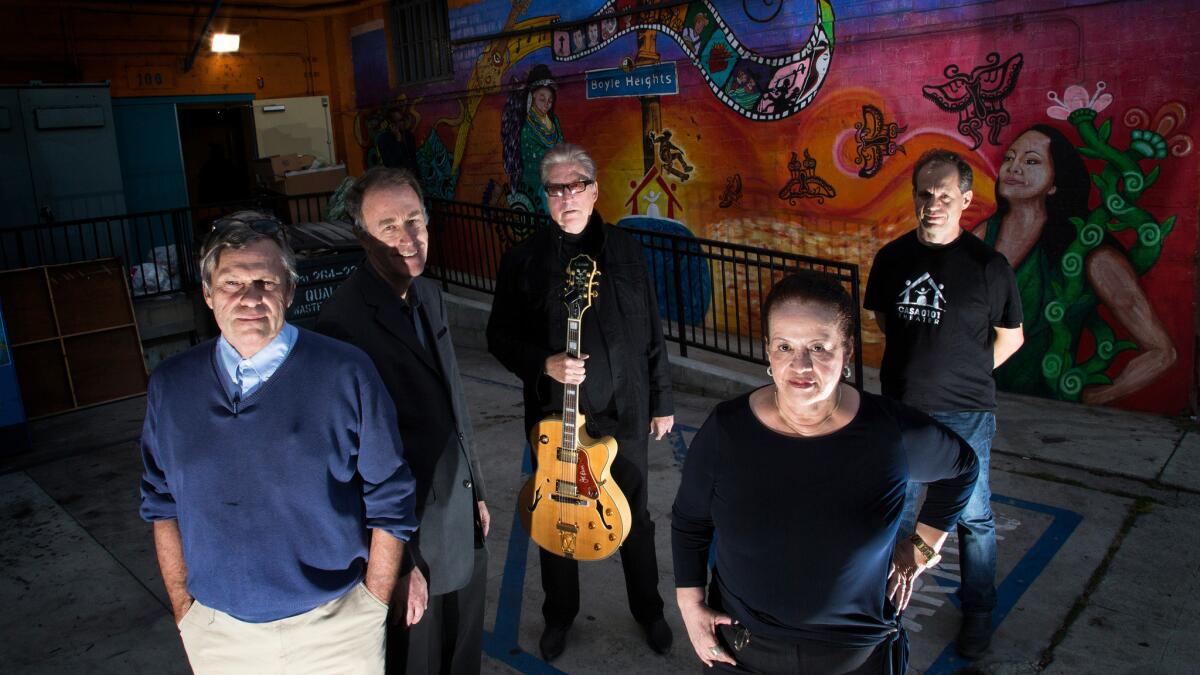‘Eastside Heartbeats’: New musical inspired by Latino band that opened for the Beatles in ’65

In 1965 the Eastside band Cannibal & the Headhunters reached the Billboard charts with “Land of 1000 Dances,” a bouncy R&B number cataloging dance moves like the pony, the mashed potato and the alligator. The song included a catchy hook — “I said, ‘a na, na na na na” — that, legend has it, lead singer Frankie “Cannibal” Garcia invented in the studio when he blanked on the lyrics.
It proved irresistible. Cannibal & the Headhunters performed on “American Bandstand,” and Paul McCartney told Brian Epstein to get the “Na na na” boys for the Beatles’ second American tour.
So four Latino teenagers found themselves opening for the Fab Four all across the country, ending up back home at the Hollywood Bowl, where they did two numbers and their signature dance move, “the rowboat,” for an elated crowd one August night in 1965.
See the most-read stories in Entertainment this hour >>
When “Eastside Heartbeats,” a new musical inspired by these events, opened this month at Casa 0101 in Boyle Heights, the festivities drew members of local bands from the era: Tierra, Thee Midniters, the Sisters, the Blendells and the Salas Brothers. (The last of the original Headhunters, Robert “Rabbit” Jamarillo, who lives in Colorado, couldn’t make it, but he did see “Eastside Heartbeats” during its trial run at Casa 0101 in January. Witnesses recall him sobbing in the audience and afterward doing “the rowboat” with the cast.)
The former rockers looked slightly grizzled compared with their 50-year-old photos on display in the lobby, but they were no less enthusiastic about the vibrant if largely forgotten music scene they helped to create. Many of them performed “Land of 1000 Dances” back in the day. You know the song too, even if you don’t know you know it: Wilson Pickett’s 1966 version, which eclipsed Cannibal & the Headhunters’, cemented “Na, na na na na” into our musical heritage.
But you won’t hear “Land of 1000 Dances” in “Eastside Heartbeats.” The musical’s fictional band sings original songs, freshly composed for them if strongly flavored by the ‘60s. Their new hit is called “Whatcha Doin’ Tonight,” and its refrain, invented by the fictional lead singer, Jimmy Ramirez, begins with another consonant and has a different catchy melody. As catchy as “Na, na na an na?” History will decide.
The morning after the opening, the musical’s creative team — book writer Tom Waldman, composer and lyricist James Holvay, director Steve E. Feinberg, Executive Producer Maria Elena Yepes and Casa 0101 Executive Director Emmanuel Deleage convened on the set to discuss how “Eastside Heartbeats” came to be and why they ultimately chose not to include “Land of 1000 Dances.”
“We had a tremendous debate,” recalled Holvay, prompting chuckles and nostalgic smiles around the table.
Waldman, the journalist and music scholar who conceived this musical, intended to dramatize Cannibal & the Headhunters’ rise to fame more or less faithfully — including their song. He and David Reyes had made the story the centerpiece of their 1998 book, “Land of 1000 Dances: Chicano Rock ‘n’ Roll From Southern California,” and Waldman had a feeling that it would work well onstage. “It’s a rock ‘n’ roll fantasy,” he said. “It’s just a great story, and it’s wonderful that it’s set here, in a community that’s wildly underrepresented in popular culture.”
Although he had never written a play before, he decided to give it a shot.
“Then I had this script,” he said wryly. “It was a musical without a composer.”
As the host of the KLCS show “Rock N’ Roll Stories,” Waldman had occasion to meet people who could help, such as composer Holvay — guitarist and member of the ‘60s R&B band the Mob who also wrote songs for the Buckinghams. Holvay came of age in Chicago, but when Waldman showed him his script, Holvay said, “I was, like, I lived this. I was Jimmy Ramirez. I played ‘Land of 1000 Dances’ in a band for years and had the dream like everybody does to have a hit record. And I ended up having a hit record, on a little tiny label, a song called ‘Kind of a Drag.’”
When someone mentioned she loves “Kind of a Drag,” Holvay nodded in mock resignation. “You owe me three cents.”
Holvay agreed to take a shot at the missing score.
“He really dove into it,” Waldman said. “He was coming back with questions about characters and scenes that indicated somebody who was taking this very seriously.”
Having seen “In the Heights” at Casa 0101 and been charmed by the space, Waldman called up executive director Deleage to see if he had any interest in the musical that was coming together.
“I was thrilled by the possibility,” said Deleage, whose wife, Josefina Lopez, founded Casa 0101 in 2000. “These kids, Cannibal & the Headhunters, were from Ramona Gardens and Estrada Courts, two housing projects where we do theater workshops, and the youth there have no idea about them. But, frankly, we’re still a community theater, growing into a professional theater. I told Tom, ‘A musical is beyond our reach. We’ll host it, we’ll open our doors to you, but you need to find the money.’”
That was when Yepes, an East Los Angeles College professor and Chicana activist who had worked with Waldman and Reyes on their book, stepped in. By uncanny coincidence, Yepes saw Cannibal & the Headhunters at the Hollywood Bowl in 1965. The band’s story resonated with her own experience as a Mexican American teenager saving up money from babysitting and cleaning jobs to buy tickets for musicians her parents didn’t entirely get. It was an era of rebellion by assimilation, when teens were turning against the traditional Mexican culture of their elders.
“Right before Cannibal & the Headhunters were supposed to go on tour with the Beatles, the boys were up north picking oranges,” Yepes said. “That was very common in my generation in East L.A. Every summer several families would travel to the fields to pick. They were up there and they received that call: ‘Come on, you guys have to come home because we’re going to go on tour.’ And they were sort of, ‘Well, should we? Maybe we should just stay and earn a little more money.’”
As “Eastside Heartbeats” was coming together, Waldman, met Feinberg, a writing partner of the late songwriting great P.F. Sloan. When Feinberg expressed interest in the musical, Waldman invited him to a meeting.
Although he eventually became the director, Feinberg’s role was undefined at first, he said. “I felt like ... you know when you go to a Cub Scout meeting and you only have the shirt, you don’t have the pants, you don’t have the full uniform? So I’m not really sure what I’m doing at the table, but I’m at the table.”
He started mixing things up pretty quickly.
“When Steve got involved,” Holvay remembered, “out of the blue he says, ‘I don’t think we should use ‘Land of a 1,000 Dances.’ An email went out, and I said, ‘He’s crazy!’ We all went nuts.”
Said Feinberg: “That was before I had my pants ... my Cub Scout pants. But my feeling was: You don’t hang a new show on an old song.”
Yepes agreed.
“I was against using the song from the beginning,” she said. “This isn’t the story of Cannibal & the Headhunters. This is a fictional story. If we use that song, there’s going to be that confusion, and then you’re going to get objections because people will say, ‘No, that’s not what happened.’ ‘No that’s not true.’ ‘Who’s that supposed to be?’”
Feinberg and Yepes, however, found themselves in the minority.
“When they told me they weren’t going to use the song anymore, I was concerned,” Deleage said. “The song was the whole hook that got me to support this project.”
The group had a meeting. “We all went around the table and voiced our opinion,” Holvay said, “and we all went, ‘No, no, no.’ It was like everybody dropping out of the Republican race. And then Steve gave this Obama speech, saying, ‘It’s not about the one song. It’s about the whole scene, about all those bands.’ We were all tied to the one song! He did this overview of what the play was about, and we went, ‘God, he’s right.’ And then I said, ‘Well, OK, but who’s going to write this song?’ They all looked at me and said, ‘You can do it.’”
Writing the replacement hit wasn’t easy — particularly when even Holvay’s family and friends remained skeptical. The manager of the studio where he records his demos reacted especially badly, Holvay recalled. “He said, ‘If you don’t use ‘Land of 1000 Dances,’ my wife and I aren’t going to come to the show.’” (He added: “They were here last night. They went crazy. They loved it.”)
Feinberg acknowledged that he took a creative risk, but he believes it has paid off. When he first put “Whatcha Doin’ Tonight” in his CD player, he thought: “This is it. This is exactly what this show needs: optimism, a little bit of naughtiness and a really, really catchy tune.”
Waldman said the decision enabled him as a writer to expand on some themes. “I was able to bring in very strong female characters and give them an identity and a role,” he said. “We also wanted to strive for immediacy. It’s not a nostalgia show. It’s a show about ambition and the role luck plays in success.”
Yepes is enthusiastic about the opportunity “Eastside Heartbeats,” which runs through May 29, provides the young performers in its large cast and live band.
“When you look at the exhibit in the lobby, the memorabilia from David Reyes’ collection, it’s very clear on that wall that there was an explosion of young teenagers making great music. Why so many of them, and why so many on the Eastside? Because the schools were offering music classes. That’s where they all learned to be musicians. And once we got into the late ‘70s and those things started to be cut back, we got to a point where places like Casa have to take all the responsibility of offering music and art, and that’s a huge loss.
“We need another wall with pictures of young people doing these things today. And the young people in this show are going somewhere. We’re going to see big things from them.”
------------
‘Eastside Heartbeats’
Where: Casa 0101, 2102 E. 1st St., Los Angeles
When: 8 p.m. Fridays, 3 and 8 p.m. Saturdays, 5 p.m. Sundays. Ends May 29.
Price: $25-$30
Contact: (323) 263-7684, www.casa0101.org
Running time: 2 hours, 20 minutes
------------
Follow The Times’ arts team @culturemonster.
More to Read
The biggest entertainment stories
Get our big stories about Hollywood, film, television, music, arts, culture and more right in your inbox as soon as they publish.
You may occasionally receive promotional content from the Los Angeles Times.










